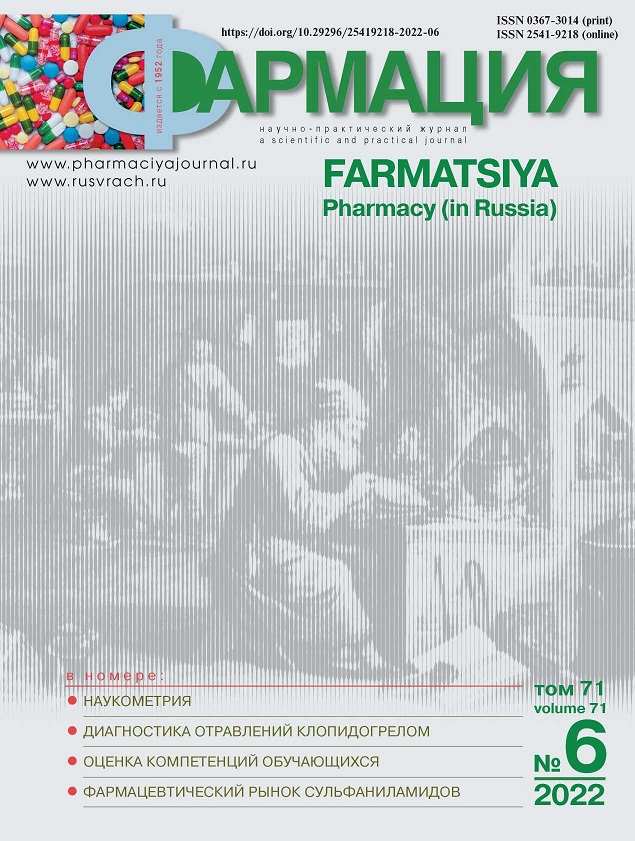Analysis of the pharmaceutical market of drugs containing a sulfanilamide group
- Authors: Skosyreva N.S.1, Melnikova O.A.1, Melnikov M.Y.1, Petrov A.Y.1
-
Affiliations:
- Ural State Medical University of Ministry of Health of Russia
- Issue: Vol 71, No 6 (2022)
- Pages: 40-45
- Section: Organization and economy
- URL: https://journals.eco-vector.com/0367-3014/article/view/113772
- DOI: https://doi.org/10.29296/25419218-2022-06-06
- ID: 113772
Cite item
Abstract
Introduction. Antimicrobial resistance (AMR) infections are currently a global public health problem. The global medical community has developed a number of measures to address this issue. One of the promising ways to overcome AMR is to create a new class of antimicrobial drugs by modifying existing drugs that have proven themselves in the treatment of infectious diseases. These parameters correspond to the group of sulfanilamide preparations. To assess the possibility of their use as a basis for modification, it is necessary to study their current range. This analysis is an important step, because the modern pharmaceutical market of the Russian Federation tends to increase the product range. Objective: to study the current range of drugs of the sulfanilamide group on the pharmaceutical market of the Russian Federation in order to identify trends in the direction of creating new drugs based on them. Material and methods. As objects of study, data from the State Register of Medicines were used, which were studied by the method of content analysis. Results. As a result of the content analysis, it was found that, due to their effectiveness in treating a wide range of diseases, drugs of the sulfanilamide group are included in 5 clinical and pharmacological groups of the State Register of Drugs at once. However, the total number of drugs of the sulfanilamide group and their dosage forms is not enough. Conclusion. It was shown that in order to improve the quality of medical care in the treatment of infectious diseases, it is necessary to create new domestically produced chemotherapeutic agents that are effective against microbial pathogens that are resistant to existing antimicrobial drugs. The content analysis performed showed that sulfanilamide group drugs are a promising class for creating new drugs based on them by modifying them.
Full Text
About the authors
Natalia Sergeevna Skosyreva
Ural State Medical University of Ministry of Health of Russia
Author for correspondence.
Email: skosyreva.nataly@mail.ru
post-graduate student at the Department of Management and Economics of Pharmacy, Pharmacognosy
Olga Alexandrovna Melnikova
Ural State Medical University of Ministry of Health of Russia
Email: newfarmacia@mail.ru
Doctor of Pharmaceutical Sciences, Professor, associate professor at the Department of Management and Economics of Pharmacy, Pharmacognosy
Mikhail Yurievich Melnikov
Ural State Medical University of Ministry of Health of Russia
Email: sasha-ber73@mail.ru
PhD in Chemical Sciences, associate professor at the Department of Pharmacy and Chemistry
Aleksandr Yurievich Petrov
Ural State Medical University of Ministry of Health of Russia
Email: uniitmp@yandex.ru
Doctor of Pharmaceutical Sciences, Professor, Head of the Department of Pharmacy and Chemistry
References
- De Kraker M.E.A., Stewardson A.J., Harbarth S. Will 10 million people die a year due to antimicrobial resistance by 2050? PLoS medicine. 2016; 13 (11): 1-6. doi: 10.1371/journal. pmed.1002184
- Kang C.-I., Kim S.-H., Park W.B. et al. Bloodstream Infections Caused by Antibiotic-Resistant Gram-Negative Bacilli: Risk Factors for Mortality and Impact of Inappropriate Initial Antimicrobial Therapy on Outcome. Antimicrob. Agents Chemother. 2005; 49 (2): 760-6. doi: 10.1128/aac.49.2.760-766.2005
- Murray C.J.L., Ikuta K.S., Sharara F. et al. Global burden of bacterial antimicrobial resistance in 2019: a systematic analysis. Lancet. 2022; 399: 629-55. doi: 10.1016/S0140-6736(21)02724-0.
- Regiel-Futyra A., Dąbrowski J. M., Mazuryk O. et al. Bioinorganic antimicrobial strategies in the resistance era. Coord. Chem. Rev. 2017; 351, 76-117. doi: 10.1016/j.ccr.2017.05.005
- Yoneyama H., Katsumata R. Antibiotic Resistance in Bacteria and Its Future for Novel Antibiotic Development. Biosci., Biotechnol., Biochem. 2006; 70 (5): 1060-75. doi: 10.1271/bbb.70.1060
- Мельникова О.А., Соколенко М.А., Сурин Р.А. Контент-анализ фармацевтического рынка противоопухолевых препаратов. Современные проблемы здравоохранения и медицинской статистики. 2021; 4: 47-61. doi: 10.24412/23122935-2021-4-47-61
- Государственный реестр лекарственных средств. [Электронное издание]. Режим доступа: https://grls.rosmin-zdrav.ru/GRLS.aspx
Supplementary files










